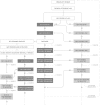Using the PMTCT Cascade to Accelerate Achievement of the Global Plan Goals
- PMID: 28398994
- PMCID: PMC5400406
- DOI: 10.1097/QAI.0000000000001325
Using the PMTCT Cascade to Accelerate Achievement of the Global Plan Goals
Abstract
Background: Development of country plans for prevention of mother-to-child HIV transmission (PMTCT), including expansion of comprehensive, integrated services, was key to Global Plan achievements.
Approaches: Use of the PMTCT cascade, an evolving series of sequential steps needed to maximize the health of women and HIV-free survival of infants, was critical for development and implementation of PMTCT plans. Regular review of cascade data at national/subnational levels was a tool for evidence-based decision making, identifying areas of greatest need at each level, and targeting program interventions to address specific gaps. Resulting improvements in PMTCT service delivery contributed to success. Populating the cascade highlighted limitations in data availability and quality that focused attention on improving national health information systems.
Limitations: Use of aggregate, cross-sectional data in the PMTCT cascade presents challenges in settings with high mobility and weak systems to track women and children across services. Poor postnatal follow-up and losses at each step of the cascade have limited use of the cascade approach to measure maternal and child health outcomes beyond the early postnatal period.
Lessons learned: A cascade approach was an effective means for countries to measure progress, identify suboptimal performance areas, and be held accountable for progress toward achievement of Global Plan goals. Using the cascade requires investment of time and effort to identify the type, source, and quality of data needed as programs evolve. Ongoing review of cascade data, with interventions to address discontinuities in the continuum of care, can translate across health areas to improve health care quality and outcomes.
Conflict of interest statement
The authors have no funding or conflicts of interest to disclose.
Figures





References
-
- UNAIDS. Countdown to Zero. Global Plan Towards the Elimination of New Infections in Children by 2015 and Keeping Mothers Alive, 2011–2015. Geneva, Switzerland: UNAIDS; 2011.
-
- World Health Organization. PMTCT Strategic Vision 2010–2015: Preventing Mother-to-Child Transmission of HIV to Reach the UNGASS and Millennium Development Goals. Geneva, Switzerland: World Health Organization; 2010.
-
- UNAIDS, World Health Organization. Revised recommendations for the selection and use of HIV antibody tests. Wkly Epidemiol Rec. 1997;72:81–88. - PubMed
-
- World Health Organization. Prevention of Mother-to-Child Transmission of HIV: Selection and Use of Nevirapine. Technical Notes. Geneva, Switzerland: World Health Organization; 2001.
-
- World Health Organization. New Data on the Prevention of Mother-to-Child Transmission of HIV and Their Policy Implications: Conclusions and Recommendations. WHO Technical Consultation on Behalf of the UNFPA/UNICEF/WHO/UNAIDS Inter-Agency Task Team on Mother-to-Child Transmission of HIV. Geneva, Switzerland: World Health Organization; 2001.
Publication types
MeSH terms
LinkOut - more resources
Full Text Sources
Other Literature Sources
Medical

